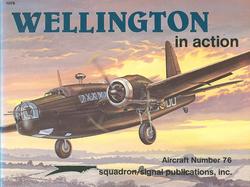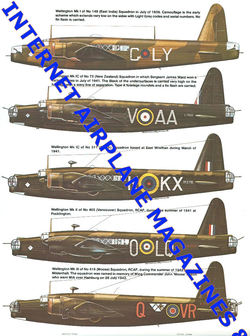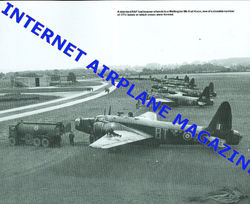SQUADRON SIGNAL WELLINGTON IN ACTION WW2 RAF BOMBER VICKERS RCAF RAAF (POLISH) (NEW ZEALAND) (CZECH)
INTRODUCTION (BARNES WALLIS, GEODETIC STRUCTURE, RAF BOMBER COMMAND, BRISTOL PEGASUS XVII RADIAL ENGINE)
WELLINGTON Mk.I
WELLINGTON Mk.IA
WELLINGTON Mk.IB
WELLINGTON Mk.IC
WELLINGTON DWI (DIRECTIONAL WIRELESS INSTALLATION) MINE WARFARE
WELLINGTON GR.Mk.VIII TORPEDO BOMBER, GR.MkVIII ANTI-SUBMARINE, LEIGH LIGHT, NOSE DEVELOPMENTS, FUSELAGE ANTENNA, WING AERIALS
WELLINGTON Mk.II
WELLINGTON Mk.III (HERCULES RADIAL ENGINE)
WELLINGTON Mk.IV (PRATT & WHITNEY TWIN WASP RADIAL ENGINE)
WELLINGTON Mk.V AND Mk.VI
WELLINGTON Mk.X
WELLINGTON Mk.XI
WELLINGTON Mk.XII ANTI-SUBMARINE
WELLINGTON GR.Mk.XIII
WELLINGTON GR.Mk.XIV
WELLINGTON C Mk.XV TRANSPORT
WELLINGTON C Mk.XVI TRANSPORT
WELLINGTON T Mk.XVII TRAINER
WELLINGTON T Mk.XVIII TRAINER
WELLINGTON T Mk.XIX
WARWICK
PHONEY WAR DAYLIGHT RAIDS
THE BATTLE OF HELIGOLAND BIGHT
MEDITERRANEAN THEATRE
LORENZ HORIZONTAL RECEIVING AERIAL
FUSELAGE WINDOW CHANGES
I HAVE HUNDREDS OF ADDITIONAL LISTINGS USING THE SIMPLE “BUY-IT-NOW” FORMAT. I SPECIALIZE IN AVIATION REFERENCE MAGAZINES AND BOOKS. I ALSO CARRY TITLES ON MILITARY HISTORY, ARMOR, TANKS, SHIPS, ELITE SPECIAL UNITS AND AMERICAN CIVIL WAR. THESE ARE EXCELLENT GIFTS & REFERENCES FOR PILOTS, MILITARY AIRCREW, VETERANS, MILITARY RE-ENACTORS, SCALE MODELERS & AIRCRAFT ENTHUSIASTS. TITLES CURRENTLY LISTED INCLUDED: THE ELITE, TAKE OFF, WARPLANE, PROFILE PUBLICATIONS, AIRCRAFT ILLUSTRATED, AIRCRAFT ILLUSTRATED EXTRA, AIR COMBAT, AIR ENTHUSIAST, AMERICAN AIRMAN AND THE ILLUSTRATED ENCYCLOPEDIA OF AIRCRAFT.
HARD TO FIND GIFTS FOR SCALE MODELERS, PILOTS, AIRCREW & VETERANS
HERE'S AN INEXPENSIVE FATHER'S DAY GIFT, BIRTHDAY PRESENT OR CHRISTMAS PRESENT FOR THE VETERAN, REENACTOR, SCALE MODELER, MILITARIA ENTHUSIAST OR HISTORY CHANNEL LOVER IN YOUR FAMILY
MONEY BACK GUARANTEE!
YOU WILL LOVE MY CUSTOMER FRIENDLY RETURN POLICY. I WANT YOU OR YOUR GIFT RECIPIENT TO BE HAPPY WITH YOUR PURCHASE. I GUARANTEE THAT THE ITEM SHIPPED WILL BE AS DESCRIBED. YOU MAY RETURN THE ITEM WITHIN 14 DAYS FOR ANY REASON. JUST EMAIL ME AND RETURN POST THE PACKAGE ADEQUATELY PROTECTED AGAINST SHIPPING DAMAGE) AND I WILL RETURN YOUR ITEM PURCHASE PRICE IN FULL.
I WILL POST POSITIVE FEEDBACK FOR YOU AFTER THE TRANSACTION IS COMPLETE AND I AM REASONABLY SURE THAT YOU HAVE RECEIVED THE ITEM. IF THERE IS ANY PROBLEM, PLEASE EMAIL ME TO WORK THINGS OUT BEFORE LEAVING FEEDBACK. MY GOAL IS TO LEAVE EVERY CUSTOMER 100% SATISFIED WITH MY PRODUCTS AND SERVICE.
--------------------------------------------------------------------------------------------------------
Additional
Information from Internet Encyclopedia
The
Vickers Wellington was a British twin-engine, long-range medium bomber. It was
designed during the mid-1930s at Brooklands in Weybridge, Surrey, led by
Vickers-Armstrongs' Chief Designer Rex Pierson; a key feature of the aircraft
is its geodesic fuselage structure, principally designed by Barnes Wallis.
Development had been started in response to Air Ministry Specification B.9/32;
issued in the middle of 1932, this called for a twin-engine day bomber capable
of delivering higher performance than any previous design. Other aircraft
developed to the same specification include the Armstrong Whitworth Whitley and
the Handley Page Hampden. During the development process, performance requirements
such as for the tare weight changed substantially, as well as the powerplant
for the type being swapped.
The
Vickers Wellington was a twin-engine long-range medium bomber, initially
powered by a pair of Bristol Pegasus radial engines, which drove a pair of de
Havilland two-pitch propellers. Various different engines and propeller
configurations were used on different variants of the aircraft, which included
several models of both the Bristol Hercules and the iconic Rolls-Royce Merlin
engines. Recognizable characteristics of the Wellington include the high aspect
ratio of its tapered wing, the depth of its fuselage, and the use of a tall
single vertical stabilizer on its tail unit, which reportedly aided in
recognition of the type.
The
Wellington typically had a crew of five. The bomb-aimer was located within the
aircraft's nose. The Wellington could be fitted with dual flight controls, and
specialized dual-control conversion sets were developed for the purpose of
performing training upon the type. The
cockpit also contained provisions for heating and de-icing equipment, which was
introduced on later models of the Wellington. The Wellington Mk I had a maximum
offensive bomb load of 4,500 lb (2,000 kg), more than one-fifth of the overall
aircraft's 21,000 lb (9,500 kg) all-up weight.
Additional munitions and an expanded bombing capacity were a recurring
change made in many of the subsequent variants of the Wellington developed
during the war, including the carrying of ever-larger bombs.
Defensive
armaments comprised the forward and tail turret gun positions, along with a
retractable revolving ventral turret. Due to the high cruising speeds of the
Wellington, it had been realized that fully enclosed turrets, as opposed to
semi-enclosed or exposed turrets, would be necessary; the turrets were also
power-operated in order to traverse with the speed and maneuverability
necessary to keep up with the new generations of opposing fighter
aircraft. Due to the specialized nature
of increasingly advanced turrets, these were treated as ancillary equipment,
being designed and supplied independently and replacing Vickers' own turrets
developed for the aircraft. The turrets initially used a Nash & Thompson
control unit, while each position was equipped with a pair of .303 in (7.7 mm)
Browning machine guns. On many Wellington variants, the Vickers-built ventral
turret of the Mk I was replaced by a Nash & Thompson-built counterpart as
standard.
A
key innovation of the Wellington was its geodesic construction, devised by aircraft
designer and inventor Barnes Wallis. The fuselage was built from 1,650
elements, consisting of duralumin W-beams which formed into a metal framework.
Wooden battens were screwed to the beams and were covered with Irish linen; the
linen, treated with layers of dope, formed the outer skin of the aircraft. The
construction proved to be compatible with significant adaptions and alterations
including greater all-up weight, larger bombs, tropicalization, and the
addition of long-range fuel tanks.
The
metal lattice gave the structure considerable strength, with any single
stringer able to support a portion of load from the opposite side of the
aircraft. Heavily damaged or destroyed beams on one side could still leave the
aircraft structure viable; as a result, Wellingtons with huge areas of
framework missing were often able to return home when other types would not
have survived, leading to stories of the aircraft's 'invulnerability'. The
effect was enhanced by the fabric skin occasionally burning off leaving the
naked frames exposed. A further advantage of the geodesic construction of the
wings was its enabling of a unique method for housing the fuel, with each wing
containing three fuel tanks within the unobstructed space provided between the
front and rear spars outboard of the engines
The
Wellington was widely used as a night bomber in the early years of the Second
World War, performing as one of the principal bombers used by Bomber Command.
During 1943, it started to be superseded as a bomber by the larger four-engined
"heavies" such as the Avro Lancaster. The Wellington continued to
serve throughout the war in other duties, particularly as an anti-submarine
aircraft. It holds the distinction of being the only British bomber to be
produced for the duration of the war and of being produced in a greater
quantity than any other British-built bomber. The Wellington remained as
first-line equipment when the war ended, although it had been increasing
relegated to secondary roles.
In
August 1936, an initial order for 180 Wellington Mk I aircraft, powered by a
pair of 1,050 hp (780 kW) Bristol Pegasus radial engines, was received by
Vickers; it had been placed so rapidly that the order occurred prior to the
first meeting intended to decide the details of the production aircraft.[15] In
October 1937, another order for a further 100 Wellington Mk Is, produced by the
Gloster Aircraft Company, was issued; it was followed by an order for 100
Wellington Mk II aircraft, which were instead powered by a pair of Rolls-Royce Merlin
X V12 engines. Yet another order was placed for 64 Wellingtons produced by
Armstrong Whitworth Aircraft. With this flurry of order and production having
been assured by the end of 1937, Vickers set about simplifying the
manufacturing process of the aircraft and announced a target of building one
Wellington per day.
Construction
took longer to build due to the geodesic fuselage in comparison to other
designs using monocoque approach, leading to criticism of the Wellington. In
particular, it was difficult to cut holes in the fuselage for access or
equipment fixtures; to aid manufacturing, the Leigh light was deployed through
the mounting for the absent FN9 ventral turret. In the late 1930s, Vickers
built Wellingtons at a rate of one per day at Weybridge and 50 a month at
Broughton in North Wales. Many of the employees on the production lines were
only semi-skilled and new to aircraft construction. Peak wartime production in
1942 saw monthly rates of 70 at Weybridge, 130 at Broughton and 102 at Blackpool.
Shadow factories were set up to produce parts for the Wellington all over the
British Isles.
In
October 1943, as a propaganda and morale-boosting exercise, workers at
Broughton gave up their weekend to build Wellington number LN514 rushed by the
clock. The bomber was assembled in 23 hours 50 minutes, and took off after 24
hours 48 minutes, beating the record of 48 hours set by a factory in
California. Each Wellington was usually built within 60 hours. It was filmed
for the Ministry of Information for a newsreel Worker's Week-End, and was
broadcast in both Britain and America. It was the first time in the world that
a British aircraft manufacturer had attempted such a feat with a metal aircraft
of this scale.
A
total of 180 Wellington Mk I aircraft were built; 150 for the RAF and 30 for
the Royal New Zealand Air Force (RNZAF) (which were transferred to the RAF on
the outbreak of war and used by 75 Squadron). In October 1938, the Mk I entered
service with 9 Squadron. The Wellington was initially outnumbered by the
Handley Page Hampden (also ordered by the Ministry to B.9/32) and the Armstrong
Whitworth Whitley (to B.34/3 for a 'night' bomber) but outlasted both rival
aircraft in service. The Wellington went on to be built in 16 separate
variants, in addition to two training conversions after the war. The number of
Wellingtons built totalled 11,461 of all versions, a greater quantity produced
than any other British bomber. On 13 October 1945, the last Wellington to be
produced rolled out.
The
Wellington Mk I was quickly superseded by several successive variants featuring
various improvements. Improvements to the turrets and the strengthening of the
undercarriage quickly resulted in the Wellington Mk IA. According to Andrews,
the IA model bore more similarities to the later Wellington Mk II than to its
Mk I predecessor. Due to armament difficulties encountered that left the
Wellington with weaker than intended defenses, the Wellington Mk IB was
proposed for trials, but appears to have been unbuilt. Further development of
various aspects of the aircraft, such as the hydraulics and electrical systems,
along with a revision of the ventral turret gun, led to the Wellington Mk IC.
In
January 1938, design work on what would become the Wellington Mk II formally
commenced. The principal change on this model was the adoption of the Merlin
engine in place of the Pegasus XVIII; other modifications included hydraulic
and oxygen system revisions along with the installation of cabin heating and an
astrodome. On 3 March 1939, L4250, the prototype Mk II, performed its maiden
flight; this had been delayed due to production delays of its Merlin X
engines. Stability and balance issues
were encountered during flight tests of the prototype, resulting in further
changes such as the enlargement of the tailplane. By late 1939, the Mk II was
capable of delivering superior performance to the Mk IC, such as higher
cruising and top speeds, increased all-up weight or alternatively greater
range, and a raised ceiling.
On
3 September 1939, the eve of the outbreak of the Second World War, No. 3 Group
of Bomber Command comprised eight squadrons (No. 9, No. 37, No. 37 No. 38, No.
99, No. 115 and No. 149 Squadrons), alongside two reserve squadrons (No. 214
and No. 215 squadrons), that were equipped with a mixture of Wellington Mk I
and Mk IA aircraft.
On
4 September 1939, less than 24 hours after the commencement of hostility, a
total of 14 Wellingtons of No. 9 and No. 149 Squadrons, alongside a number of
Bristol Blenheim aircraft, performed the first RAF bombing raid of the war,
targeting German shipping at Brunsbüttel. The bombing of the harbour itself had
not been permitted by the Chamberlain War Cabinet for fear of injuring
civilians. The effectiveness of the raid was diminished by a combination of poor
weather and high amounts of anti-aircraft fire. During this opening raid, a
pair of Wellingtons became the first aircraft to be lost on the Western Front.
On
3 December 1939, 24 Wellingtons of No. 38, No. 115 and No. 147 Squadrons
attacked the German fleet moored at Heligoland. The bombing commenced from high
altitude and, while results of the bombing itself proved negligible in terms of
damage, the ability of a formation of Wellingtons to adequately penetrate
strongly defended hostile airspace was validated. On 14 December 1939, 12
Wellingtons of No. 99 Squadron conducted a low-level raid upon German shipping
at the Schillig Roads and Wilhelmshaven. Encountering enemy fire from warships,
flak, and Luftwaffe aircraft, the Wellington formation lost five aircraft,
along with another that crashed near its base, while only one enemy fighter was
downed.
On
18 December 1939, 24 Wellingtons of No. 9, No. 37 and No. 149 Squadrons
participated in the Battle of the Heligoland Bight against the German fleet and
naval bases in both the Schillig Roads and Wilhelmshaven. The Wellingtons were
unable to deploy their bombs as all vessels were in harbour, thus restrictions
on endangering civilians prevented their engagement. Having been alerted by
radar, Luftwaffe fighter aircraft intercepted the incoming bombers near to
Heligoland and continuously attacked the formation much of the way home. In
total, 12 of the bombers were destroyed and a further three were badly damaged,
defensive fire from the turrets downed four aircraft.
The
Wellington was also adopted by Coastal Command, in which it contributed to the
Battle of the Atlantic. It was used to carry out anti-submarine duties; on 6
July 1942, a Wellington sank its first enemy vessel. Specialised DWI variants
were developed fitted with a 48 ft (14.63 m) diameter metal hoop were used for
exploding enemy mines by generating a powerful magnetic field as it passed over
them. In 1944, Wellingtons of Coastal Command were deployed to Greece and
performed various support duties during the British intervention in the Greek
Civil War. A few Wellingtons were operated by the Hellenic Air Force.
While
the Wellington was superseded in the European Theatre, it remained in
operational service for much of the war in the Middle East and in 1942, Wellingtons
based in India became the RAF's first long-range bomber operating in the Far
East. It was particularly effective with the South African Air Force in North
Africa. The Wellington also served in anti-submarine duties with 26 Squadron
SAAF based in Takoradi, Gold Coast (now Ghana).
In
late 1944, a radar-equipped Wellington XIV from 407 Sqn. RCAF was modified for
use by the RAF's Fighter Interception Unit as what would now be described as an
airborne early warning and control aircraft. It operated at an altitude of
4,000 ft (1,219 m) over the North Sea to control a de Havilland Mosquito and a
Bristol Beaufighter fighter intercepting Heinkel He 111 bombers flying from
Dutch airbases and carrying out airborne launches of the V-1 flying bomb. The
FIU operators on the Wellington would search for the He-111 aircraft climbing
to launch altitude, then direct the Beaufighter to the bomber, while the
Mosquito would attempt to intercept the V-1 if launched.
The Wellington is listed in the appendix to the novel
KG 200 as one flown by the German secret operations unit KG 200, which also
tested, evaluated and sometimes clandestinely operated captured enemy aircraft
during the Second World War.







